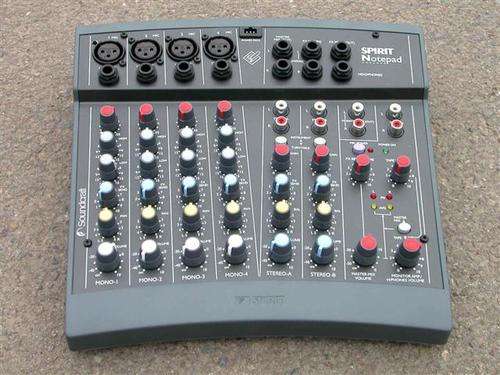
Soundcraft Spirit Folio Notepad Mixer
Check my rate
| Main centres: | 1-3 business days |
| Regional areas: | 3-4 business days |
| Remote areas: | 3-5 business days |

| Main centres: | 1-3 business days |
| Regional areas: | 3-4 business days |
| Remote areas: | 3-5 business days |
It's incredibly small, but the designers have managed to cram lots of features into a space no bigger than a mouse mat -- four mic/line channels with switchable phantom power, two stereo line/record deck channels, a stereo effects return, and a stereo tape input.
Moulded from an alarmingly lilac shade of plastic, with an integral carrying handle, the Folio Notepad has a distinctive curved styling. Power comes from an external adaptor, and the whole caboodle weighs less than 1.5kg. Car battery use is possible using Spirit's optional Portapower pack, and a stand adaptor is available, so you can mount the mixer atop a mic stand.
Each of the mic/line channels has a balanced XLR mic input and a balanced jack line input. This is followed by an input Level trim control; 2-band bass/treble EQ offering 15dB cut/boost; an effects send pot; a pan pot; and a volume pot. As the Notepad's whole channel strip is no longer than a decent long-throw fader, you can see why volume pots have been used here.
The two stereo channels are accessed via phono inputs, which are switchable to accept a line-level signal from an instrument, or the output from a record deck fitted with a magnetic cartridge. There are no EQ controls on the stereo inputs, but you still have an effects send, a balance pot and a volume control. Unusually for such a diminutive mixer, both a stereo mix output and a separate monitor amp output are provided, the latter on phonos.
The monitor source can be switched between the stereo mix and a stereo Tape return, also on phonos. The Tape input has its own separate Volume control, and level controls are also available for the Effects Send master, the Master Mix and the Monitor Amp/Headphones. Sadly, you can't route the Tape input into the stereo mix to grab an extra couple of inputs.
Phantom power is provided globally for all four mic inputs; a red LED reminds you when this is switched in. The adjacent green LED shows the Notepad is powered up. Finally on the flashing light front, basic master stereo metering is provided by a pair of LEDs, amber showing average levels and red showing peaks.
Though this is a simple and visually 'jolly' mixer, that doesn't mean you should dismiss it as somehow inferior. It doesn't have insert points, but other than that, it's a serious mixer in microcosm. For example, the EIN (a means of describing the amount of full gain mic amp noise as an equivalent noise source fed into the input), is -128.5dBu, which equals Spirit's top-end consoles, while the audio bandwidth is flat within a dB from 20Hz to 20kHz. Crosstalk is a reasonable 90dB, and the total harmonic distortion is just 0.005% or less.
Signal levels up to +18dBu can be accommodated, and while this isn't quite as high as a pro mixer, it still leaves adequate headroom for working at +4dBu operating levels. All the jack inputs may be used balanced or unbalanced, and the main output is actually impedance-balanced, which offers many of the benefits of true balancing without the inconvenience of losing half your signal level if you work unbalanced.
Because there's no PFL system, you have to set up input levels by first ensuring that the channel knob and master output knob are at 0dB, then adjusting input gain so that the amber meter LEDs are flashing but the red peak LEDs aren't. Failure to observe this nicety can result in audible distortion.
For a 2-band affair, the tonal control range of the Folio's EQ is very reasonable; enquiries revealed that the EQ frequencies are the same as those used in the rest of the Folio range of mixers.If ever a mixer deserved to be called "small but perfectly formed", it's the Spirit Notepad that earned the title. Despite its ultra-compact size and very affordable price tag, the Notepad comes with the same professional pedigree as all Soundcraft mixers, and it packed with enough features to handle a surprisingly wide range of mixing tasks.